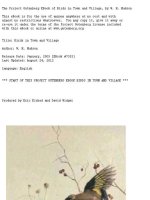The Project Gutenberg EBook of Birds of Guernsey (1879), by Cecil Smith docx
Bạn đang xem bản rút gọn của tài liệu. Xem và tải ngay bản đầy đủ của tài liệu tại đây (1.07 MB, 506 trang )
The Project Gutenberg EBook of Birds of
Guernsey (1879), by Cecil Smith
This eBook is for the use of anyone
anywhere at no cost and with
almost no restrictions whatsoever. You may
copy it, give it away or
re-use it under the terms of the Project
Gutenberg License included
with this eBook or online at
www.gutenberg.net
Title: Birds of Guernsey (1879)
And The Neighbouring Islands: Alderney,
Sark, Jethou, Herm; Being
A Small Contribution To The Ornitholony Of
The Channel Islands
Author: Cecil Smith
Release Date: December 26, 2004 [EBook
#14473]
Language: English
*** START OF THIS PROJECT GUTENBERG EBOOK
BIRDS OF GUERNSEY (1879) ***
Produced by Steven Gibbs and the PG Online
Distributed Proofreading Team
BIRDS OF
GUERNSEY
AND THE NEIGHBOURING
ISLANDS
ALDERNEY, SARK,
JETHOU, HERM;
BEING A SMALL CONTRIBUTION
TO
The Ornithology of the Channel Islands
BY
CECIL SMITH, F.Z.S.,
MEMBER OF THE BRITISH
ORNITHOLOGIST'S UNION.
LONDON:
R.H. PORTER, 6, TENTERDEN STREET,
HANOVER SQUARE.
1879.
CONTENTS.
PREFACE.
BIRDS OF GUERNSEY.
ENDNOTES.
INDEX.
PREFACE.
Though perhaps not possessing the interest
to the ornithologist which Lundy Island
(the only breeding-place of the Gannet in
the South-West of England) or the Scilly
Islands possess, or being able to produce
the long list of birds which the
indefatigable Mr. Gäetke has been able to
do for his little island, Heligoland, the
avifauna of Guernsey and the neighbouring
islands is by no means devoid of interest;
and as little has hitherto been published
about the Birds of Guernsey and the
neighbouring islands, except in a few
occasional papers published by Miss C.B.
Carey, Mr. Harvie Browne, myself, and a
few others, in the pages of the 'Zoologist,'
I make no excuse for publishing this list of
the birds, which, as an occasional visitor
to the Channel Islands for now some thirty
years, have in some way been brought to
my notice as occurring in these Islands
either as residents, migrants, or
occasional visitants.
Channel Island specimens of several of
the rarer birds mentioned, as well as of
the commoner ones, are in my own
collection; and others I have seen either in
the flesh or only recently skinned in the
bird-stuffers' shops. For a few, of course,
I have been obliged to rely on the
evidence of others; some of these may
appear, perhaps, rather questionable,—as,
for instance, the Osprey,—but I have
always given what evidence I have been
able to collect in each case; and where
evidence of the occurrence was altogether
wanting, I have thought it better to omit all
mention of the bird, though its occasional
occurrence may seem possible.
I have confined myself in this list to the
Birds of Guernsey and the neighbouring
islands—Sark, Alderney, Jethou and
Herm; in fact to the islands included in the
Bailiwick of Guernsey. I have done this as
I have had no opportunity of personally
studying the birds of Jersey, only having
been in that island once some years ago,
and then only for a short time, and not
because I think a notice of the birds of
Jersey would have been devoid of
interest, though whether it would have
added many to my list maybe doubtful.
Professor Ansted's list, included in his
large and very interesting work on the
Channel Islands, is hitherto the only
attempt at a regular list of the Birds of the
Channel Islands; but as he, though great as
a geologist, is no ornithologist, he was
obliged to rely in a great measure on
information received from others, and this
apparently was not always very reliable,
and he does not appear to have taken much
trouble to sift the evidence given to him.
Professor Ansted himself states that his
list is necessarily imperfect, as he
received little or no information from
some of the Islands; in fact, Guernsey and
Sark appear to be the only two from which
much information had been received. This
is to be regretted, as it has made the notice
of the distribution of the various birds
through the Islands, which he has denoted
by the letters a, e, i, o, u
[1]
appended to
the name of each bird, necessarily faulty.
The ornithological notes, however,
supplied by Mr. Gallienne are of
considerable interest, and are generally
pretty reliable. It is rather remarkable,
however, that Professor Ansted has not
always paid attention to these notes in
marking the distribution of the birds
through the various Islands.
No doubt many of the birds included in
Professor Ansted's list were included
merely on the authority of specimens in the
museum of the Mechanics' Institute, which
at one time was a pretty good one; and had
sufficient care been taken to label the
various specimens correctly as to place
and date, especially distinguishing local
specimens from foreign ones, of which
there were a good many, would have been
a very interesting and useful local
museum; as it is, the interest of this
museum is considerably deteriorated.
Some of the birds in the museum are
confessedly foreign, having been brought
from various parts of the world by
Guernsey men, who when abroad
remembered the museum in their own
Island, and brought home specimens for it.
Others, as Mr. Gallienne, who during his
life took much interest in the museum,
himself told me had been purchased from
various bird-stuffers, especially from one
in Jersey; and no questions were asked as
to whether the specimens bought were
local or set-up from skins obtained from
the Continent or England. Amongst those
so obtained may probably be classed the
Blue-throated Warblers, included in
Professor Ansted's list and marked as
Jersey (these Mr. Gallienne himself told
me he believed to be Continental and not
genuine Channel Island specimens), the
Great Sedge Warbler, the Meadow
Bunting, the Green Woodpecker, and
perhaps a few others.
This museum, partly from want of interest
being taken in it and partly from want of
money, has never had a very good room,
and has been shuffled and moved about
from one place to another, and
consequently several birds really
valuable, as they could be proved to be
genuine Channel Island specimens, have
been lost and destroyed; in fact, had it not
been for the care and energy of Miss C.B.
Carey, who took great pains to preserve
what she found remaining of the
collection, and place it in some sort of
order, distinguishing by a different
coloured label those specimens which
could be proved to be Channel Island (in
doing this she worked very hard, and
received very little thanks or
encouragement, but on the contrary met
with a considerable amount of genuine
obstructiveness), the whole of the
specimens in the museum would
undoubtedly have been lost; as it is, a
good many valuable local specimens—
valuable as being still capable of being
proved to be genuine Channel Island
specimens—have been preserved, and a
good nucleus kept for the foundation of a
new museum, should interest in the subject
revive and the local authorities be
disposed to assist in its formation. In my
notices of each bird I have mentioned
whether there is a specimen in the
museum, and also whether it is included in
Professor Ansted's list, and if so in which
of the Islands he has marked it as
occurring.
No doubt the Ornithology of the Channel
Islands, as is the case in many counties of
England, has been considerably changed
by drainage works, improved cultivation,
and road-making; much alteration of this
sort I can see has taken place during the
thirty years which I have known the
Islands as an occasional visitor. But Mr.
MacCulloch, who has been resident in the
Islands for a much longer period—in fact,
he has told me nearly double—has very
kindly supplied me with the following
very interesting note on the various
changes which have taken place in
Guernsey during the long period he has
lived in that island; he says, "I can well
recollect the cutting of most of the main
roads, and the improvement, still going on,
of the smaller ones. It was about the
beginning of this century that the works for
reclaiming the Braye du Valle were
undertaken; before that time the Clos du
Valle
[2]
was separated from the mainland
by an arm of the sea, left dry at low water,
extending from St. Samson's to the Vale
Church. This was bordered by salt
marshes only, covered occasionally at
spring tides by the sea, some of which
extended pretty far inland. The meadows
adjoining were very imperfectly drained,
as indeed some still are, and covered with
reeds and rushes, forming excellent shelter
for many species of aquatic birds. Now,
as you know, by far the greater part of the
land is well cultivated and thickly
covered with habitations. The old roads
were everywhere enclosed between high
hedges, on which were planted rows of
elms; and the same kind of hedge divided
the fields and tenements. Every house, too,
in those days had its orchard, cider being
then universally drunk; and the hill-sides
and cliffs were covered with furze brakes,
as in all country houses they baked their
own bread and required the furze for fuel.
Now all that is changed. The meadows are
drained and planted with brocoli for the
early London market, to be replaced by a
crop of potatoes at the end of the summer.
The trees are cut down to let in the sun.
Since the people have taken to gin-
drinking, cider is out of favour and the
orchards destroyed. The hedges are
levelled to gain a few perches of ground,
and replaced in many places by stone
walls; the furze brakes rooted up, and the
whole aspect and nature of the country
changed. Is it to be wondered at that those
kinds of birds that love shelter and quiet
have deserted us? You know, too, how
every bird—from the Wren to the Eagle—
is popped at as soon as it shows itself, in
places where there are no game laws and
every man allowed to carry a gun."
This interesting description of the changes
—agricultural and otherwise—which
have taken place in the Islands, especially
Guernsey, during the last fifty or sixty
years (for which I have to offer Mr.
MacCulloch my best thanks), gives a very
good general idea of many of the
alterations that have taken place in the
face of the country during the period
above mentioned; but does not by any
means exhaust them, as no mention is
made of the immense increase of orchard-
houses in all parts of Guernsey, which has
been so great that I may fairly say that
within the last few years miles of
glasshouses have been built in Guernsey
alone: these have been built mostly for the
purpose of growing grapes for the London
market. These orchard-houses have, to a
certain extent, taken the place of ordinary
orchards and gardens, which have been
rooted up and destroyed to make place for
this enormous extent of glass. But what
appeared to me to have made the greatest
change, and has probably had more effect
on the Ornithology of the Island,
especially of that part known as the Vale,
is the enormous number of granite quarries
which are being worked there (luckily the
beautiful cliffs have hitherto escaped the
granite in those parts, probably not being
so good); but in the Vale from St.
Samson's to Fort Doyle, and from there to
the Vale Church, with the exception of
L'Ancresse Common itself, which has
hitherto escaped, the whole face of the
country is changed by quarry works and
covered with small windmills used for
pumping the water from the quarries.
These quarry works and the extra
population brought by them into the Island,
all of whom carry guns and shoot
everything that is fit to eat or is likely to
fetch a few "doubles" in the market, have
done a good deal to thin the birds in that
part of the Islands, especially such as are
in any way fit for sale or food, and
probably have done more to make a
change in the Ornithology of that part of
the Island than all the agricultural changes
mentioned by Mr. MacCulloch. Indeed, I
am rather sceptical as to the agricultural
changes above described having produced
so much change in the avifauna of the
Islands during the last fifty years as Mr.
MacCulloch appears to think; there is still
a great deal of undrained or badly drained
land in the Island—especially about the
Vale, the Grand Mare and L'Eree—which
might still afford a home for Moorhens,
Water Rails, and even Bitterns, and all
that class of wading birds which delight in
swampy land and reed beds. Though no
doubt, as Mr. MacCulloch said, many
orchards have been destroyed to make
room for more profitable crops or for
orchard-houses, still there are many
orchards left in the Island. I think,
however, many, if not all the cherry
orchards (amongst which the Golden
Orioles apparently at one time luxuriated)
are gone. There is also still a great deal of
hedgerow timber, none of it indeed very
large, but in places very thick; in fact, I
could point out miles of hedges in
Guernsey where the trees, mostly elm,
grow so thick together that it would be
nearly impossible to pick out a place
where one could squeeze one's horse
between the trees without rubbing one's
knees on one side or the other, probably
on both, against them, if one found it
necessary to ride across the country. True,
on a great extent of the higher part of the
Island, all along on both sides of what is
known as the Forest Road, there is little or
no hedgerow timber, the fields here being
divided by low banks with furze growing
on the top of them. Furze brakes also are
still numerous, the whole of the flat land
on the top of the cliffs and the steep
valleys and slopes down to the sea on the
south and east side of the Island, from
Fermain Bay to Pleimont, being almost
uninterrupted wild land covered with
heather, furze, and bracken; besides this
wild furze land, there are several thick
furze brakes inland in different parts of the
Island. All these places seem to me to
have remained almost without change for
years. The furze, however, never grows
very high, as it is cut every few years for
fuel; in consequence of this, however, it is
more beautiful in blooming in the spring
than if it had been allowed several years'
growth, covering the whole face of the
ground above the cliffs like a brilliant
yellow carpet; but being kept so short, it is
not perhaps so convenient for nesting
purposes as if it was allowed a longer
growth.
The Guernsey Bird Act, which applies to
all the Islands in the Bailiwick, and has
been in force for some few years, seems
to me to have had little effect on the
numbers of the sea-birds of the district,
though it includes the eggs as well as the
birds, except perhaps to increase the
number of Herring Gulls and Shags
(which were always sufficiently
numerous) in their old breeding-stations,
and perhaps to have added a few new
breeding-stations. These two birds
scarcely needed the protection afforded by
the Act, as their nests are placed amongst
very inaccessible rocks where very few
nests can be reached without the aid of a
rope, and consequently but little damage
was done beyond a few young birds being
shot soon after they had left the nest while









